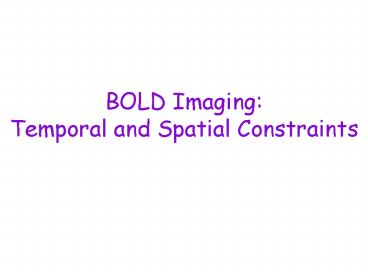BOLD Imaging: Temporal and Spatial Constraints - PowerPoint PPT Presentation
1 / 39
Title:
BOLD Imaging: Temporal and Spatial Constraints
Description:
BOLD Imaging: Temporal and Spatial Constraints – PowerPoint PPT presentation
Number of Views:41
Avg rating:3.0/5.0
Title: BOLD Imaging: Temporal and Spatial Constraints
1
BOLD Imaging Temporal and Spatial Constraints
2
What we will learn
- BOLD
- Temporal resolution of fMRI
- Hemodyamic response function (HRF)
- Spatial resolution of fMRI
- Point spread function (PRF)
- Intra and extra vasculature components of BOLD
- Parenchyma
- Chapters 7 8
3
Spatial resolution
Temporal resolution
4
Functional MRI Facility
5
Blood Oxygen Level Dependent (BOLD) Signal
- neural activity ? ? blood flow ? ? oxyhemoglobin
? ? T2 ? ? MR signal
Source Jorge Jovicich
6
BOLD Signal
Source Doug Nolls primer
7
First Functional Images Generated with BOLD Signal
Kwong et al. 1992
8
First Functional Images Generated with BOLD Signal
Ogawa et al. 1992
9
Regions that activate more strongly for moving
vs. stationary visual stimuli
Bra
Motion vs static -log(p)
10
Temporal Resolution of fMRI
- TR (time to acquire the volume)
- Temporal resolution of BOLD responses
- Temporal resolution of changes in CBF
- Temporal resolution of changes in CBV
11
Regions that activate more strongly for moving
vs. stationary visual stimuli
Bra
Motion vs static -log(p)
12
Hemodynamic Response
Block stimulation
Short stimulation
time to rise signal begins to rise soon after
stimulus begins time to peak signal peaks 4-6
sec after stimulus begins post stimulus
undershoot signal suppressed after stimulation
ends
signal change (BOLD(t) baseline)/baseline u
sually 0.5-3
13
Relation of BOLD to CBV and CBF
14
How would you measure the temporal resolution of
fMRI?
15
How would you measure the temporal resolution of
BOLD?
- Measure response with faster TR (sample time
course of hemodynamic response more finely) - Change the duration of stimulation and see the
effecs on the timing of the hemodynamic response - Measure time to rise, time to peak, time to
return to baseline - Need a model!
16
Temporal Resolution of BOLD sampling with
different TR
17
Variability of HRF Aguirre, Zarahn DEsposito,
1998
- HRF shows considerable variability between
subjects
different subjects
- Within subjects, responses are more consistent,
although there is still some variability between
sessions
same subject, same session
same subject, different session
Jody Culhams fMRI for Dummies web site
18
Linear Systems Approach
19
Comparing the real and estimated fMRI Response
20
Spatial Resolution of fMRI
- Voxel Size (and subsequent data analysis)
- Relation between BOLD and neural activity
- Point spread function of the BOLD
- Spatial scale of the structures you image
- (e.g.cortical columns)
- Separation between different structures
- (e.g., distance between columns)
21
A Voxel is made of.
4mm
5mm
4mm
22
Voxel Size
- Smaller voxels
- less deoxy hemoglobin - less BOLD
- linear relation
- Smaller voxels
- less partial voluming - increase in BOLD
- Need more time to acquire the same volume
- with small voxels
- - tradeoff between coverage and resolution
- - TR limiting factor
23
Limitations for Spatial Resolution
24
How would you measure the spatial resolution of
fMRI?
25
Eccentricity vs. mm on cortex
Engel, Glover Wandell, 1997
26
Measuring the Point Spread Function (PSF)
Shmuel et al. 2007
27
Measuring the Point Spread Function (PSF)
Shmuel et al. 2007
28
Estimate of the FWHM of the BOLD PSF is 2mm
29
Effect of PSF on Imaging Small Structures
30
BOLD Imaging of Ocular Dominance Columns in Human
V1
Single condition
Cheng et al. 2001
31
Time s
Cheng et al. 2001
32
Reproducibility of Ocular Dominance Columns in
Human V1
Cheng et al. 2001
33
Optical Imaging
34
The Initial Dip vs. BOLD (I.e. watering the
entire garden for one flower)
35
A small rectangular stimulus that should activate
a small square area on the brain surface was
shown to the monkey, and imaging based on
intrinsic signal was performed. A The expected
activation map obtained exclusively from the
period of the "initial dip", showing the expected
activation of a rectangular area on the cortical
surface. B Poor activation map from the late
period (around 6s), displaying strong vascular
artifacts. C, The bloodvessel pattern in the
imaged cortical area . D and E Same maps as in
A and B, color-coded. Scale bar shows the
intensity of the intrinsic signal in all panels.
F same image as B, re-sampled at low spatial
resolution (0.6mm). (Vanzetta and Grinvald
unpublished results).
36
High-resolution fMRI methods
- Use a 6-cm-diam surface coil
- Worn tightly against head
- Bigger signal-to-noise ratio
- Smaller FOV
This 6-cm-diam prototype surface coil is designed
to be worn tightly against the head. The coil is
shown positioned to image early visual cortex
the prominent blue foam pads were included to
improve subject comfort.
37
Anatomical Human ImagesSmall surface coil
- 400-mm isotropic voxels
- Good gray-white contrast
38
Hemoglobin
Hemoglogin (Hgb) - four globin chains -
each globin chain contains a heme group - at
center of each heme group is an iron atom (Fe)
- each heme group can attach an oxygen atom
(O2) - oxy-Hgb (four O2) is diamagnetic ? no
?B effects - deoxy-Hgb is paramagnetic ? if
deoxy-Hgb ? ? local ?B ?
Source http//wsrv.clas.virginia.edu/rjh9u/hemog
lob.html, Jorge Jovicich
39
Terminology
- CBV Cerebral Blood Volume
- CBF Cerebral Blood Flow
- HBr Deoxy- Hemoglobin
- HRF Hemodyanmic Response Function































